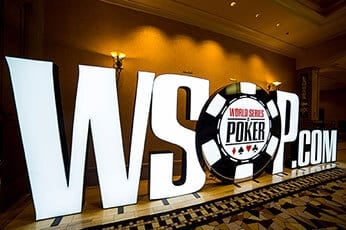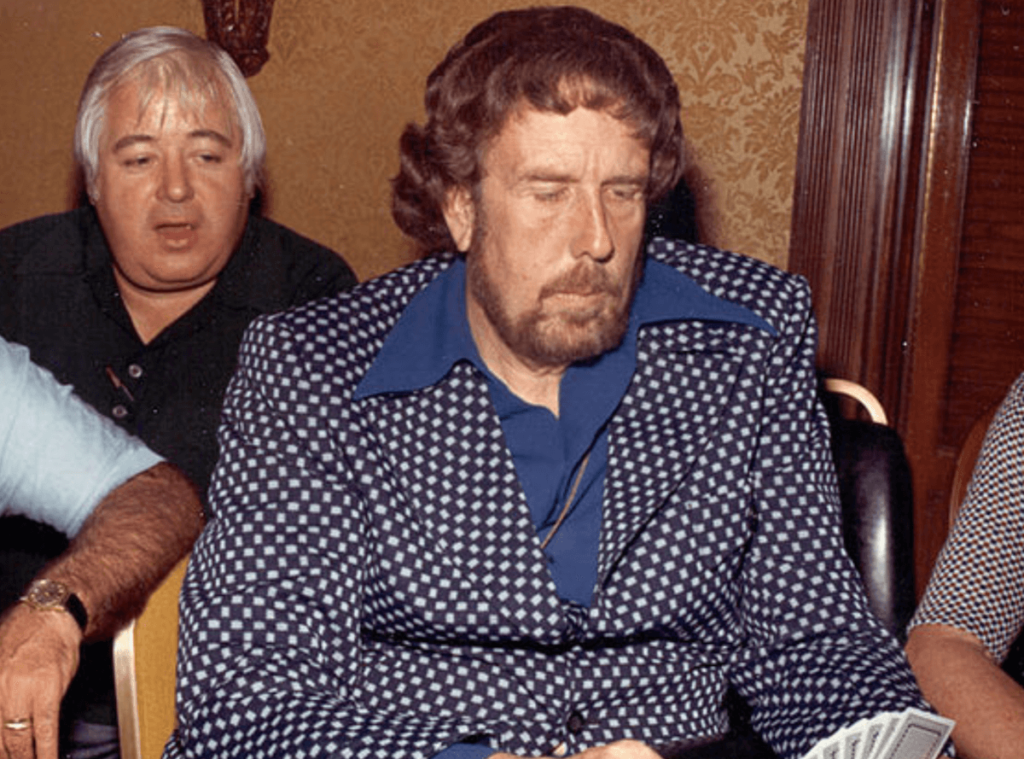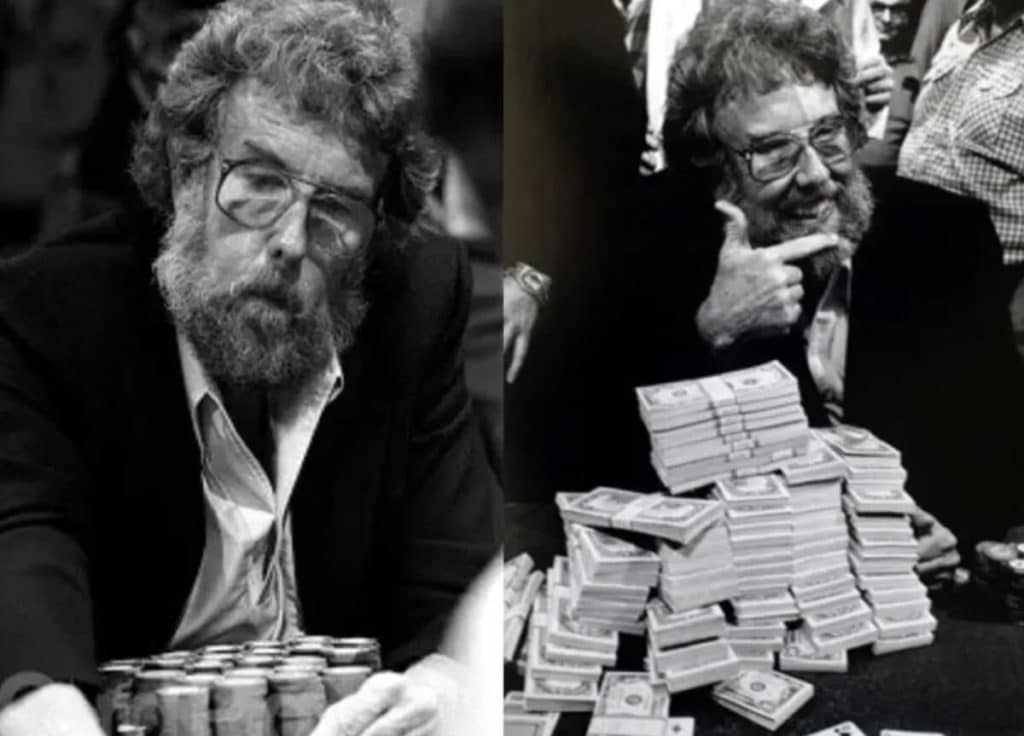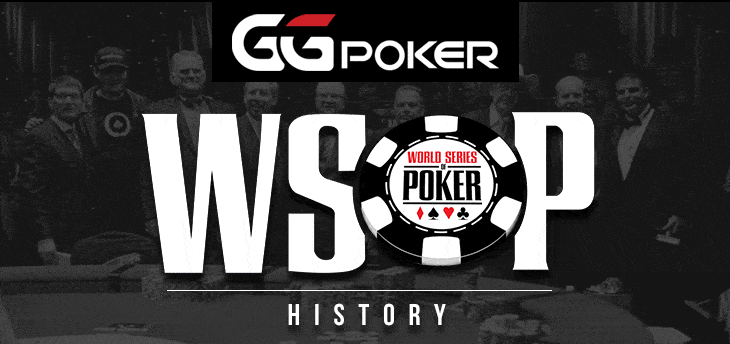The Story of the 1982 WSOP Main Event
From its formative years of action in Las Vegas, the World Series of Poker had changed significantly as it entered its 13th year in 1982. The first half of the 1970s had seen many early growth issues ironed out and the series expanded from a single WSOP Main Event to a festival of tournaments that concluded with the World Championship.
This transformation had spread from the events themselves to the players, with old hands like Johnny Moss and Doyle Brunson, who won five of the first eight World Championships, joined by exciting young talents like Bobby Baldwin and Stu Ungar, who was the reigning champion having won the main event two years running in 1980 and 1981.
In 1982, so many firsts happened. From the story of a single poker chip, through the not-so-humble wristwatch, to a tree that wouldn’t be felled, 1982 was a unique year of action that included the Main Event seeing over 100 entrants for the first time in its history.

The 1982 WSOP Welcomes the World
In the 13th year of the World Series of Poker, there were 14 WSOP events, one more than the previous year. Tournaments ran from May 9th through May 27th, with six full days of action in the Main Event. This year, however, there were no bracelets at all. That was because a decision had been made prior to the festival to change the trophy for winning a WSOP event to a wristwatch following criticism that ‘bracelets were too feminine.’ It was observed that no previous male winners wore their bracelets, so golden wristwatches were awarded for each event in 1982.
By 1983, this decision was seen for the madcap mistake it was and wristwatches were banished to the annals of poker history. Bracelets were back in circulation from 1983 and there they have remained until the present day over 40 years later.
Early events proved popular, so much so that players from all over the world attended and for the first time in its history, the WSOP paid out in cash to winners from countries other than the United States. Until 1982, no foreigner had ever cashed in a WSOP event, but that streak ended with Englishman Barry Clayton, South African Hugh Todd, Greek player Dennis Zervos, and Noli Francisco from The Philippines all ending in the money during the festival.

Preliminary Events See Baxter and Sklanksy Bag Doubles
Of the 13 events that were played in the build-up to the 1982 WSOP Main Event, several saw the largest fields they ever had. A massive 192 players took on the $1,000 No Limit Hold’em event #4 which was won by Jim Doman for $96,000, followed by the largest player pool to date when 202 were toppled by John Paquette in Limit Hold’em event #9 for $101,000. Those two were new names, Jim Doman would continue his poker career earning nearly $1 million in lifetime tournament cashes, but most of the big wins went to a bevy of familiar players. The opening two events of the 1982 WSOP were both won by Billy Baxter, in No Limit A-5 Draw Lowball and No Limit 2-7 Draw Lowball, for a combined total of $143,750.
Wins for Tom Cress, June Field and Nick Helm followed in the $1,000 Limit Seven Card Stud Hi-Lo event #3, $500 Ladies Limit Seven Card Stud event #5, and $1,000 Limit Razz event #6 respectively before the $800 Mixed Doubles event #7 saw Dani Kelly and David Sklansky end victorious.
A special amateur event was held as the $1,500-entry Non-Professional No Limit Hold’em tournament, event #8 took place, with Ralph Morton scooping the $123,000 top prize. Event wins – wristwatch wins even – followed for Chip Reese, Vera Richmond – the first woman to win a WSOP event other than the Womens/Ladies Championship or the Mixed Doubles – and Don Williams.
Sklansky, who had been on the winning Mixed Doubles team, earned more headlines with success in the $1,000 Limit Draw High event, his second title of the series. Known as ‘The Mathematician’, Sklansky would go on to win just one more WSOP event – finally winning a bracelet – in 1983, but it was his work as a poker author which impacted poker more than anything. Sklansky has written or contributed to 14 books on poker, blackjack, and other forms of gambling, including the books Hold’em Poker (1976), The Theory of Poker (2006), and Hold’em Poker for Advanced Players (1999) all proving hugely popular with players at every level.
A Chip and a Chair
Ahead of the Main Event starting, the Poker Manager Eric Drache noticed a cash game that was running near the tables reserved for the World Championship with around $10,000 in chips on the table. Drache suggested that if players played for the all of money on the table, using a structure with escalating blinds in a ‘Sit ‘N’ Go format, then whoever won the table would be able to enter ithe $10,000 buy-in World Championship.
This is the earliest confirmed poker satellite tournament recorded and in the decades to follow, qualifying for the WSOP Main Event via satellite would prove to be an historic and growing tradition. From satellites inside the Horseshoe to local casinos around the country, WSOP Main Event satellites would eventually spread to the internet when online poker was introduced to the medium. In 2023, GGPoker alone sent 774 players to the World Series of Poker via online satellites.
When the WSOP Main Event kicked off, it had an incredible 104 entries, including past winners, new qualifiers and introduced a brand-new champion in Jack ‘Treetop’ Straus. The legend of Jack Straus includes many tall tales from the man known as ‘Treetop’ for his 6’7” frame and overbearing, larger-than-life personality. Straus, who famously wore a lion’s paw around his neck that was inscribed with the motto: “Better a day as a lion than one hundred years as a lamb”. He was a player who, as the story goes, once bluffed a man off a huge cash game pot holding just seven-deuce. Strauss offered to show the opponent one of his cards for $25. The man picked the deuce and folded the pot with the bigger pair after the flop.
The greatest miracle of Straus’ poker life, however, took place during the early stages of the WSOP Main Event of 1982. Confident of winning a hand, Straus thought he had pushed all of his chips into the middle. Straus lost the hand and believed that he was out of the Main Event, only to discover a single chip that remained in front of his seat. According to legend, it might have been wedged between the felt and his cup-holder, under a napkin or disguised by his drink, but it hadn’t been pushed into the middle.
The tournament organisers were called over and deemed that since Straus never uttered the words “All in”, his single chip, worth just $500 of his $10,000 stake, was still his with which to play. Straus sat back down having just a ‘chip and a chair’ and doubled up in the next hand to over 1,000 chips. By the end of Day 2, he had 90,000 chips and by the close of Day 3, Straus had more chips than anyone else in the tournament with 341,500.
Suddenly, the greatest comeback of all time, the miracle of winning the biggest poker event ever, the 1982 World Championship, was a real possibility.

One in a Million
With a prizepool of $1.04 million, the biggest ever by far, had a top prize of $520,000 that was guaranteed to go to the winner. By the time the final nine players had battled their way into the money places, Doyle Brunson was once again looking a good shot to win his third WSOP Main Event. Early exits for players such as Carl Cannon, the 1975 WSOP world champion Brian ‘Sailor’ Roberts and George ‘Buster’ Jackson saw all three of those players rewarded with $20,800. Six remained, including the ‘Chip and a Chair’ player who was still reaching for the title.
Dody Roach busted in sixth place for $41,060 before A.J. Myers left in fifth for $52,000. In fourth, Doyle Brunson was eliminated, the last remaining former world champion unable to make it three world championships inside a six-year period. That left three, and when Berry Johnston missed out on heads-up play, Straus was one player away from the nearly impossible victory.
Treetop, however, now faced his easiest job. Up until 1982, Straus had never been close enough to battle heads-up for the World Championship. The road gambler, more used to traveling across Texas for the next big game, was a heads-up specialist and now had his chance. Straus was famed for once saying: “If they’d wanted you to hold onto money they would have made it with handles on.”
Putting his money where his mouth was, Straus took just 15 minutes to dismantle his opponent, schoolteacher Duane ‘Dewey’ Tomko. Already a bracelet winner thanks to his win in the 1979 $1,000 No Limit Hold’em event, Tomko was a tough opponent but Straus had destiny on his side and a notorious heads-up game in his arsenal. All-in with ace-ten in the final hand, Straus was ahead of Tomko, who was at risk with ace-four. A four on the flop threatened to spoil the fairytale for Treetop, but the rivered ten saved him and the man who had been down to just a single chip early on in the Main Event was the world champion.
Dewey Tomko would recover from the beat, and win big in his career, although it would take him 19 years to reach the heads-up stage of the World Championship again but that is a story for another day.
Sadly, the same cannot be said for the 1982 world champion. In 1988, Jack ‘Treetop’ Straus was playing a high stakes cash game when his heart gave out. He died sitting at the poker table in the Bicycle Casino in Las Vegas, aged just 58.

| Place | Player | Country | Prize |
|---|---|---|---|
| 1st | Jack Strauss | United States | $520,000 |
| 2nd | Dewey Tomko | United States | $208,000 |
| 3rd | Berry Johnston | United States | $104,000 |
| 4th | Doyle Brunson | United States | $52,000 |
| 5th | A.J. Myers | United States | $52,000 |
| 6th | Dody Roach | United States | $41,060 |
| 7th | George Jackson | United States | $20,800 |
| 8th | Bryan Roberts | United States | $20,800 |
| 9th | Carl Cannon | United States | $20,800 |
1981 WSOP Main Event 1983 WSOP Main Event
About the Author: Paul Seaton has written about poker for over 10 years, interviewing some of the best players ever to play the game such as Daniel Negreanu, Johnny Chan and Phil Hellmuth. Over the years, Paul has reported live from tournaments such as the World Series of Poker in Las Vegas and the European Poker Tour. He has also written for other poker brands where he was Head of Media, as well as BLUFF magazine, where he was Editor.

